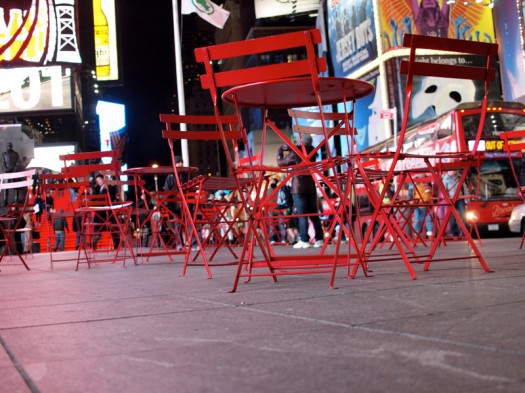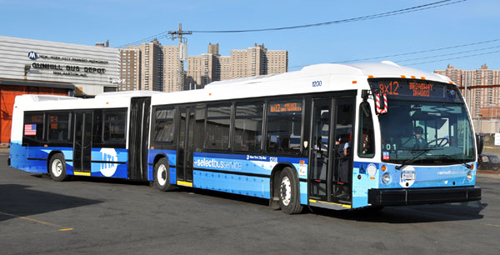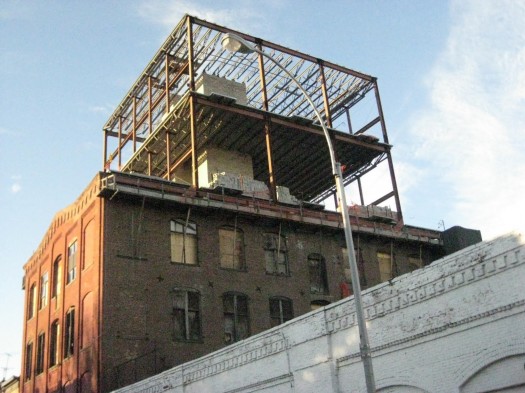
We are celebrating 15 years — and counting — of stories that are deeply researched and deeply felt, that build a historical record of what the city has been.
We are celebrating 15 years — and counting — of stories that are deeply researched and deeply felt, that build a historical record of what the city has been.

Times Square, courtesy of Flickr user Jack Amick
Midtown loungers and lunchers rejoice! Despite rumors last week that the Broadway pedestrian plazas had not met expectations, this week city officials announced that the partial closure of seven city blocks to autos will be permanent. Traffic congestion goals were only met partially, with 7% overall faster traffic flow on average on 6th and 7th Avenue, but it looks like significant improvements in both pedestrian and motorist/passenger safety and positive feedback from locals outweighed traffic questinos. For the official lowdown, see the DOT’s official report here. Plaza pedestrians will have something new to see this weekend — Moorhead & Moorhead have designed The Ice Heart, a project commissioned by the Times Square Alliance for Valentine’s Day, installed at 46th St. and Broadway. The 10 foot tall ephemeral valentine is constructed entirely of masonry scaled blocks of ice and will remain in place until it melts away.
In Omnibus-related news, we see that we aren’t the only ones enthralled by The East Harlem School at Exodus House. Suzanne LaBarre also took an in depth look at the school and the design of its new building for Metropolis’ January issue. For those of you who enjoyed Leni Schwendinger’s account of her underground tour of the Atlantic Avenue Tunnel, make sure you check out more of her pics in the photo essay published on her blog. And if you were intrigued by Travis Eby’s review of the Myrtle Avenue Pedestrian Plaza pop-up exhibit, it’s not too late to attend the follow-up workshop hosted by the Myrtle Avenue Brooklyn Partnership tomorrow, Saturday, February 13th, from 12-5pm. Streetsblog offers its own review of the pedestrian plaza proposals and includes images of a plethora of the submissions, from Aaron Follett’s bus shelter to Christopher Pell’s tent-like open air structures.
Also on Streetsblog, the renovation of the High Bridge restoration is finally moving after a year and a half of delays. The bridge will offer a welcome link between the Bronx and Manhattan as the only bridge that is exclusive to pedestrian and bicycles between the two boroughs. Built in 1848 as a part of the Croton Aqueduct, the bridge helped deliver New York City’s water supply from upstate until it was taken out of service in 1958.

Novabus LFS, courtesy of the MTA
There’s a new bus in town, the Novabus LFS, and it has three doors, low floors, a clean diesel engine and a rear window! The first of the ninety new articulated vehicles that will eventually hit the roads can be found on the Bx12 Select Bus Service (SBS) route which runs between the Bronx’s Bay Plaza/Co-op City and 207th St. in Manhattan. The new design, in conjunction with off-board fare collection and enforcement of bus-only lanes, is expected to significantly reduce wait and travel time along the route, and the advanced technology implemented in the vehicles will keep maintenance and operating costs low. The MTA calls it the bus of the future. Bronx riders, hop on and let us know if you agree. (via Planetizen)
Stage-enthusiasts, take note: The New York Times reports that the Royal Shakespeare Company is constructing a theater inside the Wade Thompson Drill Hall of the Park Avenue Armory for a six-week, five play run as part of the Lincoln Center festival. The theater is a near exact replica of the company’s home theater in Shakespeare’s hometown of Stratford-on-Avon. The performances are scheduled to run between July 6 and August 14 in the summer of 2011.
As you watch tonight’s opening ceremonies of the 2010 Winter Olympics, check out the venues and facilities behind the events and festivities. Olympic host cities are challenged with the tremendous task of planning, designing, upgrading and constructing a wide range of venues, facilities and infrastructure to support and house the games and their participants, all the while being sure that the new developments can be repurposed for civic and community use after the games end. Check out Nate Berg’s Places interview with Vancouver planning director Brent Toderian about all of these challenges, the Vancouver model of city building, and the choice to focus on sustainability over architectural exuberance. Then flip through The Infrastructurist’s slideshow of Vancouver’s Olympic construction. Arenas are up first, but stay tuned for looks at the visitor and athlete complexes and the city’s transportation improvements, coming soon.
Despite some new construction and renovation projects that are moving forward in the city, not everything is going so well. The New York Times looks at the financing and control struggles throwing our city’s parks into limbo. As the city’s coffers have become depleted by the recession, city parks are increasingly looking to private options to help finance construction and maintenance. Brooklyn Bridge Park is looking to concession stands and even fees from adjacent housing developments to help raise cash. The problem isn’t limited to New York City — parks nationwide are tackling similar problems.

A stalled development at 333 Carroll Street, referred to by neighborhood residents as “The Hell Building,” via stalleddevelopment.com
Stalled construction sites have been one of the most visible indicators of economic woes. Last year the DOB created a task force to address the problem of stalled sites, and last summer started releasing regular reports on dormant projects around the city. Now Councilman Brad Lander has created a website highlighting stalled development in his Brooklyn district, which ranges from Windsor Terrace to Gowanus to Cobble Hill, in an effort to highlight the plight of neighborhoods when developers pull out of construction projects, leaving holes in the urban fabric. If you live in his district, click through and notify him of the conditions of the neighborhood.
Now we send you into the holiday weekend with two of the more unusual items that came across our desks this week — a pirate museum and liquid glass:
The Wall Street Journal reports that Canadian developer Jerry Shefsky is hoping to begin construction on a $100 million aquarium / pirate museum in Times Square if all goes according to plan. As it’s slated to be located inside a seven-story skyscraper at 11 Times Square, the attraction will largely be made up by educational exhibitions and the swashbuckling museum instead of the heavy water tanks you typically find in aquariums.
Physorg.com published an article with a hyperbolic title that we’re tempted to believe — “Spray-on liquid glass is about to revolutionize almost everything.” Applications for the product are being researched at the Leibniz Institute for New Materials in Saarbrücken, Germany and it is already being tested in the wider world by organizations as varied as a hospital, a train company and even a German burger joint. (via kottke)
The Roundup keeps you up to date with topics we’ve featured and other things we think are worth knowing about.
The views expressed here are those of the authors only and do not reflect the position of The Architectural League of New York.
Comments